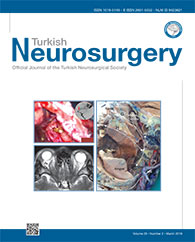2M.S. Ramaiah Medical College, Department of Neurosurgery, Bangalore, India DOI : 10.5137/1019-5149.JTN.22071-17.2 AIM: To describe the authors' experiences with surgical excision of cerebral arteriovenous malformations (AVMs) using temporary proximal artery clipping to reduce intraoperative bleeding and excision time.
MATERIAL and METHODS: Temporary proximal artery clipping was employed by the authors during surgery on 14 patients with cerebral AVMs in a public-sector institution. Seven AVMs were situated in eloquent areas like the sensory, motor, and speech areas and the other seven were located in non-eloquent areas. Four patients each were classified as Spetzler grades 2 and 4 while three patients each were classified as grades 3 and 5. A large craniotomy flap was fashioned to enable access to the proximal feeding arteries along with the AVM. After wide dural opening, the proximal feeding arteries were first approached. The proximal middle cerebral artery was approached by opening the proximal sylvian cistern, an interhemispheric approach was employed for the distal anterior cerebral artery, and a subtemporal route was used for the P2 portion of the posterior cerebral artery. After placing a temporary aneurysm clip on the proximal feeding artery, excision of the AVM was performed, employing the basic principles of AVM excision.
RESULTS: Total excision of the AVM was achieved in all cases. There were no instances of cerebral infarction or neurological deficits attributable to temporary clipping of the proximal artery. There was no mortality in this series.
CONCLUSION: Temporary proximal artery clipping helps in surgical excision by reducing intraoperative bleeding and resection time.
Keywords : Arteriovenous malformation, Brain, Excision, Temporary artery clipping




